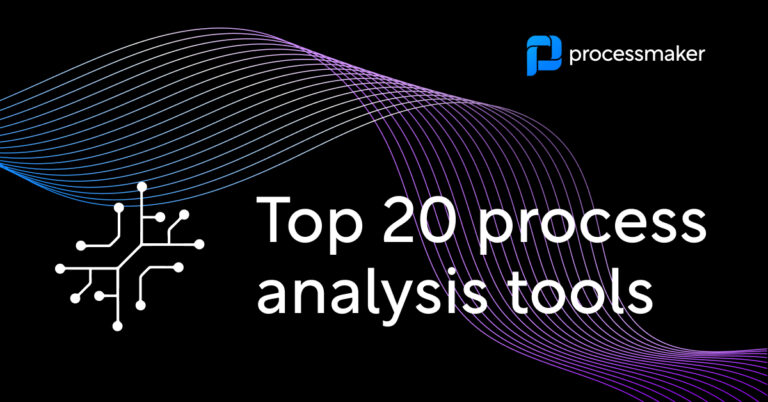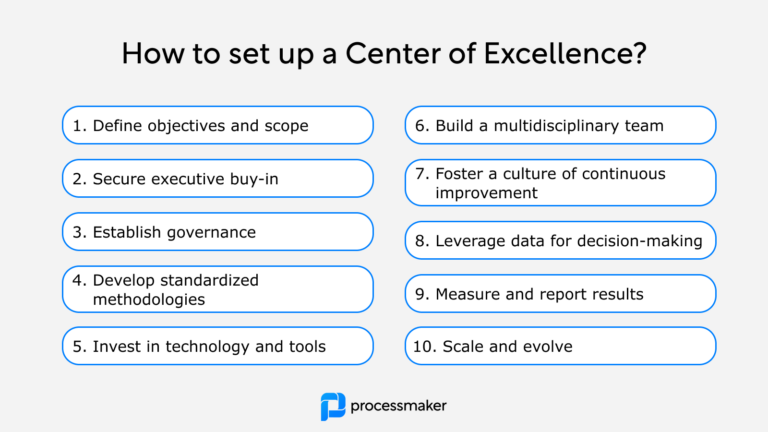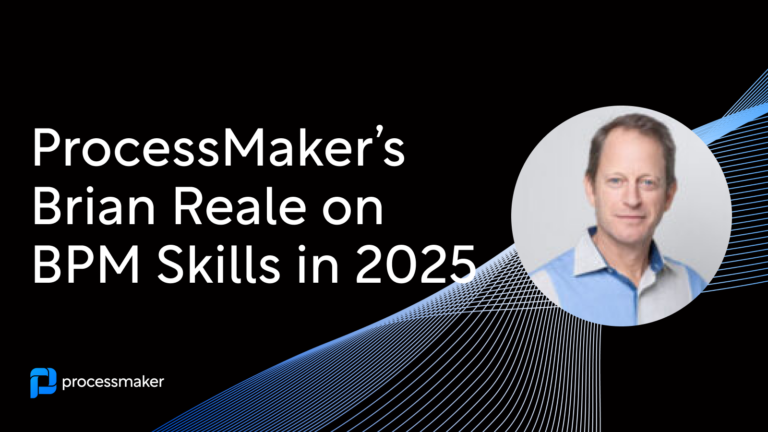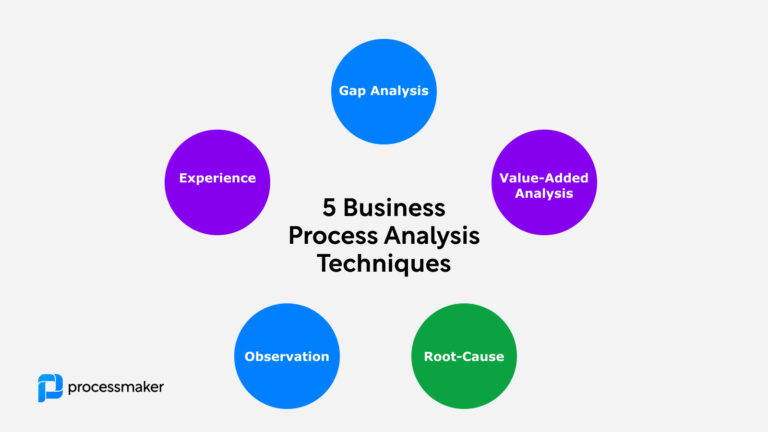Process analysis plays a vital role in business operations, facilitating smooth operational execution and optimizing productivity. When you apply business process analysis, you gain clarity about your ‘as-is’ processes, enabling informed decision-making based on a comprehensive understanding of current workflows. Several tools and techniques can make process analysis easier and more effective. Let’s go through your top options and what you need to know to make an informed decision.
What is a business process analysis tool?
A business process analysis tool is a software application or platform that helps businesses visualize, understand, and improve their existing processes. Business process analysis involves thoroughly examining and understanding these processes to pinpoint inefficiencies and areas for improvement. These tools facilitate process mapping, modeling, automation, measurement, and improvement, enabling organizations to streamline their operations for better efficiency and productivity.
Business process analysis solutions typically provide features like:
- Process mapping: This feature allows you to create visual representations of your business processes, making it easier to understand and communicate how different tasks flow within your organization.
- Workflow automation: Some of these tools enable you to automate repetitive tasks, reducing the risk of human errors and freeing up time for more valuable activities.
- Performance tracking: These tools can measure key metrics related to your processes, such as completion times, costs, and success rates. This data can be instrumental in identifying bottlenecks and areas for improvement.
- Collaboration features: Many business process analysis tools offer collaboration capabilities, allowing multiple team members to contribute to the process analysis and improvement efforts.
Business process analysis techniques vs tools
Process analysis tools are software applications or platforms used to map, track, and visualize business processes. They offer tangible, often automated methods of capturing, analyzing, and presenting data. For instance, a business process management (BPM) tool can help automate and optimize workflows, while a data analysis tool like Tableau can process vast amounts of data to extract meaningful insights.
While business process analysis focuses specifically on assessing and improving business processes, business analysis encompasses a broader range of activities, including identifying organizational needs and problems, financial controls, and strategic planning.
On the other hand, process analysis techniques are methodologies or strategies used to understand and interpret the data obtained from the tools. They provide a framework for analyzing processes and making informed decisions.
For instance, a flowchart is a technique that helps visualize the steps in a process, making it easier to identify bottlenecks or inefficiencies. Similarly, SWOT analysis is a strategic planning technique used to identify strengths, weaknesses, opportunities, and threats related to a process, project, or business decision.
Business process analysis tools and techniques are interconnected – tools provide the means to collect and handle data, while techniques guide the interpretation and application of this data. The combined use of suitable tools and techniques can lead to more effective process analysis and consequently, improved business performance.
Business process analysis tool examples
Business process analysis tools come in all shapes and sizes. Some cater to small businesses, while others focus on the needs of large enterprises. Some focus on root cause analysis, while others offer process simulation and planning functionality.
Implementing business process analysis methods systematically is crucial for assessing and enhancing business operations, and exploring various types of analysis suited to specific business needs.
The most common types of business process analysis tools include:
- process intelligence software,
- workflow management software,
- business process management tools,
- business process modeling tools.
Process analysis tools can also be used together. For example, a process mining tool can be used to first understand business processes, while a BPM solution is used to execute process improvements.
What to look for in process analysis tools
Choosing the right process analysis software is a critical decision that can significantly impact your business operations. Business process analysis (BPA) plays a crucial role in evaluating, improving, and streamlining specific processes within a company, ensuring efficiency and effectiveness in a fast-evolving technological landscape. Here are some factors you should consider:
- Functionality: The software should have the essential features you need, such as process modeling, simulation, automation, performance tracking, and collaboration capabilities. A robust tool will cater to your specific requirements and streamline your workflow.
- User-friendliness: The software should be intuitive and easy to use. Your team should be able to learn and adapt to it quickly. A steep learning curve can delay implementation and decrease overall productivity.
- Integration: The software should integrate smoothly with other systems and tools your business already uses. This ensures seamless data flow and prevents information silos.
- Scalability: As your business grows, your process analysis needs might evolve. The software should be scalable to accommodate this growth and adapt to changing requirements.
- Vendor support: Reliable customer service is crucial. The software provider should offer adequate training, technical support, and regular updates.
- Security: The software must have robust security measures in place to protect your business data. This includes encryption, user authentication, and data backup facilities.
- Cost: The price of the software should align with its features and the value it brings to your business. Consider both the upfront costs and the long-term costs, including updates and maintenance.
Remember, the best process analysis software is the one that fits your business’s unique needs and contributes to your organizational goals. Always try to test the software, if possible, before making a final decision.
Key questions to answer before looking for process analysis tools
- Do we actually need a tool for business process analysis?
- Do we have the process performance metrics in place to configure tooling?
- How can process analysis tools help us better meet our customer or business needs?
- Do we have the process knowledge and process data needed to leverage process analysis tools?
- Are we ready to drive through the change management and operational changes driven by process analysis?
- Could we perform gap analysis, value-added analysis, or other expert-driven process analyzing methods to complement the data-driven approach given by tools?
Top process analysis tools to consider
Let’s go through five of the top types of tools used for business process analysis, starting with process intelligence software.
Process analysis tool example – Workfellow Process Intelligence
Process intelligence software
Process intelligence software offers real-time visualization and insight into business processes through data mining methods. It combines data mining, machine learning, and business process management to analyze end-to-end business processes and workflows, enabling businesses to identify bottlenecks, inefficiencies, and opportunities for optimization. The most common types of process intelligence include process mining and task mining tools.
1. ProcessMaker process intelligence (PI)
ProcessMaker PI is the first hybrid process intelligence platform that integrates top elements of process and task mining into one AI-powered solution. It is especially popular with knowledge-intensive digitalized businesses where many business applications and tools are used in core workflows and processes. ProcessMaker’s unique process intelligence technology is up to 10 times faster to implement than conventional process mining, while still providing 100% coverage of process, tasks, and systems analysis.
- Pros: Unique plug-and-play technology makes process intelligence faster and more accessible without the need for data science and integration resources.
- Cons: ProcessMaker acquired this process intelligence solution recently (by acquiring a software startup called Workfellow), so it does not yet have the widest set of partners in this field outside Europe.
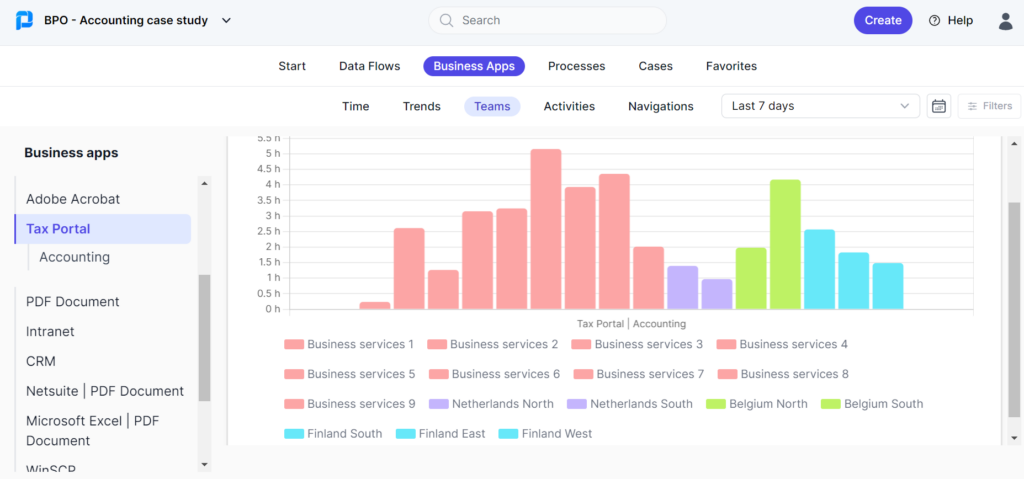
Screenshot of a process intelligence tool ProcessMaker: a usage of a specific business app by different teams in a specified timeframe.
2. Celonis
Celonis is a market-leading process mining software known for its Execution Management platform of process analysis tools including process and task mining. It helps businesses visualize their operations, identify bottlenecks, and discover areas for process improvement. Celonis’ advanced event log data mining functionality and wide set of complementary solutions make it a top choice for many enterprise businesses.
- Pros: Celonis is a powerful process mining tool that excels in visualizing process flows and identifying bottlenecks. It also integrates well with many systems, especially within the SAP data ecosystem.
- Cons: The software can be complex for beginners and may require significant training. Also, some users have reported difficulties in dealing with large volumes of data.
3. UiPath Process Mining (formerly ProcessGold)
UiPath Process Mining, formerly known as ProcessGold, is a comprehensive solution that provides businesses with a deep understanding of their processes, highlighting inefficiencies, and offering recommendations for optimization. Part of the larger UiPath suite, it integrates seamlessly with UiPath’s Robotic Process Automation (RPA) tools, allowing companies to automate their improved processes easily. It is particularly useful for large-scale enterprises seeking to streamline their workflows.
- Pros: UiPath Process Mining offers an intuitive interface and excellent integration with other UiPath products. It supports real-time process monitoring and offers solid analytical features.
- Cons: The tool may need enhancements in scalability and the ability to handle complex data structures and different data sources.
4. IBM Process Mining (formerly myInvenio)
IBM Process Mining, previously known as myInvenio, is a powerful tool for businesses to analyze and optimize their operations. By leveraging advanced algorithms, this software provides a clear visual representation of business processes, allowing organizations to identify inefficiencies and compliance risks. It’s designed to integrate smoothly with other IBM software, making it a comprehensive solution for businesses looking to enhance their process management strategy.
- Pros: IBM Process Mining offers comprehensive process mining capabilities, including process discovery, conformance checking, and enhancement. It has a user-friendly interface and integrates well with other IBM products.
- Cons: The tool’s advanced features can be complicated for beginners, requiring training. There could be improvements in visualization capabilities and ability to integrate to different source systems.
5. Microsoft Minit
Minit is a process mining tool that helps organizations visualize and analyze their business processes, pinpointing bottlenecks and opportunities for improvement. Minit provides a granular view of business operations, facilitating informed decision-making and promoting operational efficiency. With its increasingly wide integrations to Microsoft’s Power Automate solutions and robust analytics capabilities, Minit is an excellent tool for businesses of all sizes leveraging Microsoft’s data and solution platform.
- Pros: Minit provides solid process mining capabilities, including process visualization, bottleneck analysis, and conformance checking. It’s known for its user-friendly interface and good customer support.
- Cons: Some users have found difficulties in managing complex process maps. There could be improvements in advanced analytics features and data integration capabilities.
Workflow management software
Workflow management software is a set of tools designed to streamline and automate routine business operations. It helps in organizing and coordinating tasks and activities within a workflow, enabling seamless transfer and execution of tasks between individuals or teams. The software maps out the sequence of tasks, assigns them to the appropriate team members, and tracks the status until completion.
1. ProcessMaker
Apart from a process intelligence tool, ProcessMaker also offers a full-suite business process automation (BPA) platform. It offers features for designing, automating, and deploying business processes.
- Pros: ProcessMaker is highly customizable to any of customers’ business needs. It utilizes the power of generative AI to make the automation process easier and more efficient. Additionally, it doesn’t require extensive technical expertise and skills to get started with the platform.
- Cons: While it’s easy to get started with the simpler workflows, the more complex ones will need some technical knowledge to set them up.
2. Monday.com
Monday.com is a work operating system that enables organizations to create custom workflow apps in minutes to run their projects and everyday work. Its unique feature includes its color-coded board system which can be customized to fit any type of workflow.
- Pros: Monday.com offers a visually appealing and intuitive interface. It is highly customizable and offers a robust set of collaboration and project management features.
- Cons: Some users may find the pricing structure a bit expensive, especially for smaller teams. It may also require some training time to fully exploit its capabilities.
3. Kissflow
Kissflow is a unified digital workplace platform that allows businesses to manage all their work on a single, unified platform. Kissflow is unique in its approach to offer process management, project management, case management, collaboration and productivity tools, and advanced analytics in a single suite.
- Pros: Its user-friendly interface makes it easy to use, even for non-technical users. The software also supports integration with a wide range of other business applications.
- Cons: The reporting features could be more robust, and some users have reported slow response times from the customer support team.
4. Zoho Creator
Zoho Creator is a low-code platform that allows you to build and launch custom applications for your business needs. It’s unique in its capability to enable users to build mobile applications with minimal coding knowledge, thereby democratizing mobile app development.
- Pros: Zoho Creator offers a flexible and powerful platform for building custom business applications. It supports automation and integration with other Zoho products and third-party applications.
- Cons: The software can be complex to set up and may require technical knowledge or assistance. The user interface could be more intuitive.
5. Process Street
Process Street is a process management platform that offers businesses a robust and straightforward approach to managing repeating business procedures and checklists. Its unique feature is its simplicity and strength in managing repetitive processes and tasks.
- Pros: Process Street’s simple interface makes it easy to use. It offers a solid set of features for automating tasks and integrating with other tools.
- Cons: While it’s excellent for straightforward processes, it might not be as suitable for managing complex workflows. The software also lacks in-depth reporting and analytics capabilities.
6. Trello
Trello is a task management and collaboration tool that organizes your projects into boards. Its unique feature is its card-based layout which allows users to visualize their tasks and workflows effectively.
- Pros: Trello’s simplicity and visual approach to task management make it a popular choice for managing business processes. It is easy to use and flexible, with a range of plugins for added functionality.
- Cons: Trello may be too simple for complex project management needs and lacks advanced features like time-tracking or automated workflows that other tools offer. It also might not scale well for large teams or complex projects.
Business process management platforms
Business process management platforms are software tools that allow businesses to design, model, implement, monitor, and optimize their operational processes for increased efficiency and effectiveness.
1. ProcessMaker
ProcessMaker combines process intelligence, workflow management, and generative AI capabilities to boost productivity by transforming how organizations manage and execute their business workflows.
- Pros: ProcessMaker offers exceptional customization to meet any organization’s BPM needs, all while maintaining a simple interface and user-friendly experience.
- Cons: ProcessMaker goes beyond process management by providing comprehensive automation capabilities. However, some users seeking only BPM features may view this extensive functionality redundant.
2. SAP Signavio
SAP Signavio combines process modeling, data mining, real-time decision management, and workforce intelligence. Its collaborative approach encourages all users to participate in business transformation.
- Pros: Signavio provides a comprehensive set of BPM tools with an intuitive and user-friendly interface. Its cloud-based platform allows easy access from anywhere.
- Cons: Some users report that customer support needs improvement, and there may be difficulties handling complex processes.
3. Appian
Appian is a low-code BPM platform that enables businesses to develop apps quickly. It integrates AI and RPA capabilities, automating and optimizing business processes.
- Pros: Appian offers robust process modeling and automation features. It is versatile, providing solutions across various industries.
- Cons: The tool can be expensive, and its user interface may require a steep learning curve for some users.
4. Nintex
Nintex offers an easy-to-use, drag-and-drop interface for process mapping and automation. It also provides advanced workflow analytics.
- Pros: Nintex provides robust features for automating complex business processes. The platform integrates well with SharePoint and Office 365.
- Cons: Some users report that error messages can be difficult to understand. Additionally, the software could be more flexible in terms of customization.
5. Bizagi
Bizagi offers a platform with capabilities like process modeling, automation, and optimization. It also features a free version for small businesses.
- Pros: Bizagi is known for its user-friendly interface and comprehensive set of BPM tools. It supports collaboration and facilitates easy sharing of process documentation.
- Cons: Some users report that while Bizagi is excellent for modeling and documentation, it may fall short in terms of process execution and automation. Also, the software could be more intuitive for first-time users.
6. Camunda
Camunda is an open-source platform for workflow and decision automation that enables organizations to model, automate, and optimize their business processes. It offers a comprehensive suite of tools and features, including process modeling, workflow execution, and decision management.
Pros: Camunda is highly customizable due to its open-source nature, allowing organizations to tailor it to their specific needs. It offers a user-friendly interface and supports the integration of third-party systems.
Cons: Camunda’s flexibility can also make it more complex to implement and configure, requiring a certain level of technical expertise. While it provides a rich set of features, some advanced functionalities may require additional development efforts.
Process modeling tools
Business process modeling tools are software applications that assist in mapping out the current process in an organization, often using graphical representations. They are used to create a visual blueprint of the steps involved in a business process, allowing for a better understanding and analysis of the process.
Creating a process map is a crucial step after gathering all relevant data during business process analysis, as it helps identify bottlenecks and streamline operations. These tools facilitate the identification of inefficiencies, bottlenecks, and unnecessary steps in a process, providing a foundation for process improvement and optimization.
1. ProcessMaker
ProcessMaker platform follows Business Process Modeling Notation (BPMN) 2.0 specification for creating visually appealing flowcharts and process models on its intuitive platform. That being said, process modeling has just become even simpler. Powered by AI, users can now get process models and diagrams by simply entering a description of what they wish to achieve, eliminating the need to build a process manually.
- Pros: ProcessMaker provides users with an easy-to-use interface that significantly simplifies the modeling process.
- Cons: ProcessMaker is more than just a process modeling platform; it boasts a range of features and capabilities that might overwhelm users looking for a simple modeling tool.
2. Lucidchart
Lucidchart provides an intuitive and collaborative platform for creating a wide range of diagrams, including business process models. It supports real-time collaboration and integrates with various other applications.
- Pros: Lucidchart’s interface is user-friendly and straightforward. It offers a large library of templates and supports a wide range of diagram types.
- Cons: While powerful, Lucidchart lacks some of the advanced features that more specialized business process modeling (BPM) tools offer.
3. Visio
Visio is a diagramming and vector graphics application from Microsoft. It includes a range of templates for business process modeling and supports BPMN.
- Pros: Visio integrates well with other Microsoft products and offers a comprehensive range of features for diagramming.
- Cons: Visio can be expensive compared to other tools, and its interface may feel outdated compared to more modern alternatives.
4. Creatio
Creatio, formerly known as Bpm’ online Studio, offers process modeling, automation, and control. It includes features for CRM and sales force automation.
- Pros: Creatio provides a range of powerful features for business process management, including a user-friendly low-code platform.
- Cons: Some users report that the software has a steep learning curve, and its pricing may be high for smaller businesses.
5. ARIS Express
ARIS Express is a free modeling tool from Software AG. It supports a range of modeling notations, including BPMN.
- Pros: ARIS Express is free and provides a range of features suitable for smaller businesses or those new to business process modeling.
- Cons: Compared to the full ARIS suite, ARIS Express is somewhat limited in its functionality. It also lacks collaboration features.
Bottom line
The effectiveness of process analysis in an organization relies heavily on the proper use of tools and techniques. It’s a strategic investment that can result in improved productivity, efficiency, and profitability. Remember, the goal isn’t to master every single tool and technique but rather to understand which ones will deliver the most value to your organization and how to use them effectively.
Choosing the right tool or technique depends on your business needs, the complexity of your processes, and your team’s capabilities. Keep in mind that the most effective approach often involves a combination of tools and techniques. So don’t be afraid to mix and match. Experiment until you find what works best for your unique business scenario.
FAQs:
1. What are process analysis tools used for?
Process analysis tools and techniques aim to understand, analyze, and improve business processes for increased efficiency and productivity.
2. How often should you do process analysis?
The frequency of process analyses varies depending on the business and its needs. However, as a general rule, they should be carried out regularly to ensure continuous improvement.
3. Which process analysis tool is best suited for my business?
The choice of tool largely depends on the specific requirements of your business, the complexity of your processes, and the capabilities of your team.
4. What is the difference between process analytics and data analytics?
The difference between process analytics and data analytics is that process analytics focuses specifically on analyzing and optimizing business processes, while data analytics involves the broader examination and interpretation of data to extract insights and inform decision-making.
5. What are examples of automated process analysis?
Automated process discovery methods leverage technology to automatically trace and map out business processes, reducing the time and effort involved in manual process mapping. One example is Process Mining, which utilizes event logs generated by enterprise systems to create a detailed visual map of a process. It identifies the sequence of tasks, their dependencies, and variations, providing an objective view of the process based on factual data.
Another example is Task Mining, which applies AI and machine learning to user interaction data, such as screen recordings or keystrokes, to map out processes. It’s particularly useful for processes involving a lot of human interaction. Automated process discovery methods provide a more accurate, efficient, and objective approach to process discovery compared to traditional manual methods.
